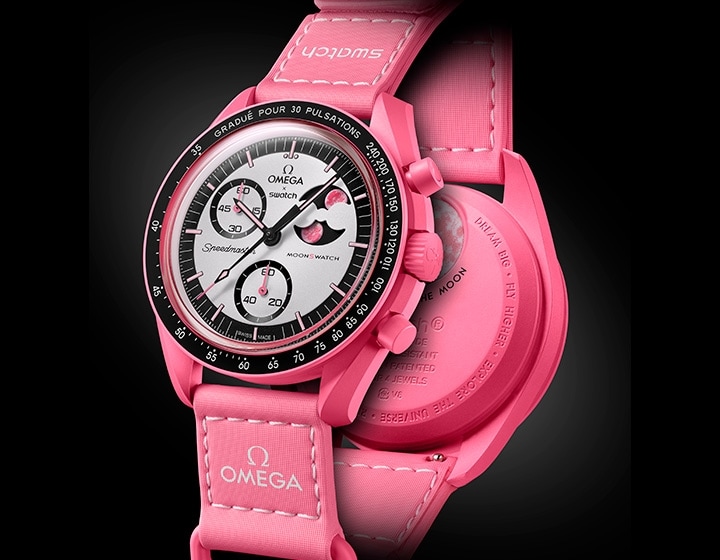Swatch Ocean of Storms

BIOCERAMIC SCUBA FIFTY FATHOMS DISCOVERS A SIXTH OCEAN, OCEAN OF STORMS
A new ocean is joining the five watches and five oceans in the Blancpain X Swatch collaboration. Even though planet Earth only has five, Swatch is welcoming OCEAN OF STORMS into its Bioceramic Scuba Fifty Fathoms Collection that celebrates Blancpain’s iconic Fifty Fathoms, a watch that revolutionized watchmaking by becoming the first true diver’s watch more than seventy years ago. Known by the Latin name Oceanus Procellarum, this is actually a lunar mare located on the western edge of the near side of the moon. Meaning Ocean of Storms, it is the biggest mare or "sea" on the moon, spanning more than 2,500 kilometers from north to south and covering around 2 million square kilometers. The new Bioceramic Scuba Fifty Fathoms OCEAN OF STORMS, however, is nowhere near that big. In fact, it has exactly the same dimensions and features as ARCTIC OCEAN, PACIFIC OCEAN, ATLANTIC OCEAN, INDIAN OCEAN and ANTARCTIC OCEAN.
A non-limited model, OCEAN OF STORMS, comes in a black color inspired by the new moon (also known as the Black Moon). Just like the other five Bioceramic Scuba Fifty Fathoms, OCEAN OF STORMS has a Swatch mechanical movement, SISTEM51, the first and only mechanical movement whose production is entirely automated. This mechanism, made up of just 51 parts - including one central screw, is anti-magnetic, thanks to its Nivachron™ hairspring and has a 90-hour power reserve. In 2013, SISTEM51 revolutionized the world of automatic watches with its visible movement: the front tells the time, the back tells the story.
OCEAN OF STORMS has been given its own nudibranch (scientific name: Nudibranchia), Okenia Luna. It is featured in a digital print on the movement’s rotor, the part that allows the watch to recharge automatically with a simple movement of the wrist. The full moon zoomed in on the Ocean of Storms is also digitally imprinted on the oscillating weight.
OCEAN OF STORMS, like ARCTIC OCEAN, PACIFIC OCEAN, ATLANTIC OCEAN, INDIAN OCEAN and ANTARCTIC OCEAN, is water resistant in deep waters, down to 91 meters. This is another nod to Blancpain: the name Fifty Fathoms refers to the fathom – historically the maritime measure of depth in the English-speaking world – fifty fathoms equaling 91 meters (or 300 feet).
In the same spirit as the other five models in the collection, OCEAN OF STORMS is made of Bioceramic. This unique material is patented by Swatch and made of two-thirds ceramic and one-third biosourced material derived from castor oil. As an expression of commitment to ocean preservation, the NATO straps are made from recycled fishing nets.
The shared Blancpain X Swatch logos can be found on the black sunray-finish dial and the crown. The word “Swatch” is also inscribed on the case, just as “Blancpain” is inscribed on the original Fifty Fathoms watches. The back of the watch features inspirational inscriptions like PASSION FOR DIVING – LICENCE TO EXPLORE – OCEAN BREATH – PROTECT WHAT YOU LOVE and IMMERSE YOURSELF.
Related news

Blancpain Fifty Fathoms
Born from an icon that has shaped the history of watchmaking, the Fifty Fathoms Automatique 42mm in stainless steel joins Blancpain's permanent collection. Following the success of the 2023 limited edition, the Fifty Fathoms 70th Anniversary Act 1, and the brushed grade 23 titanium and red gold versions launched last year, this new model pays…

MOONSWATCH MISSION TO THE PINK MOONPHASE
This April, Swatch will be celebrating the annual appearance of the Pink Moon with the Bioceramic MoonSwatch MISSION TO THE PINK MOONPHASE. Fans can purchase this unique timepiece only for a limited time starting from April 1, and only at selected Swatch sales locations, specifically those which will feature a miniature pink Rolling Planet! This…

MoonSwatch 1965
In 1965, the OMEGA Speedmaster was the only watch to pass the tests of the American space agency NASA. That was exactly sixty years ago, on March 1, 1965. As part of the development of the American space program, NASA required a watch that was reliable, precise, easy to read, and easy to use for its space missions. The objective: to have a…





